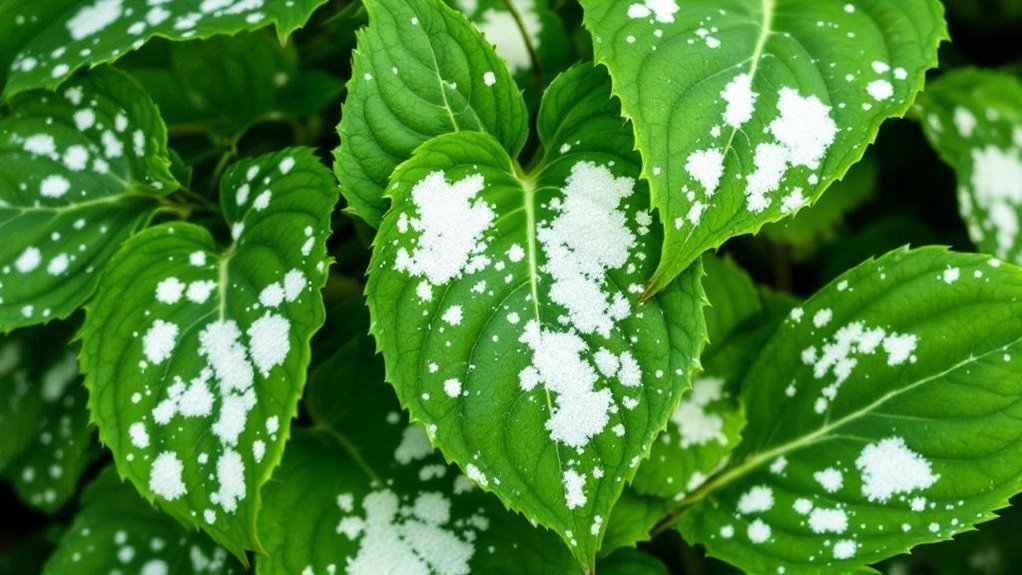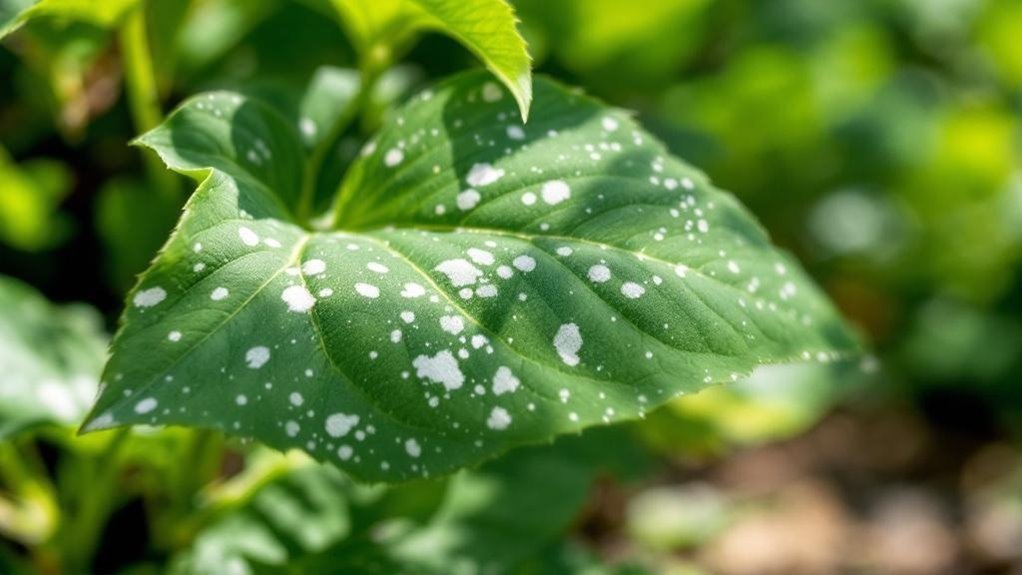Imagine your plant’s leaves as a canvas suddenly dusted with tiny white specks—an unsettling sight that hints something’s amiss beneath the surface. You might be facing anything from fungal infections to sneaky pests or even nutrient imbalances. Understanding the cause is essential because each issue demands a different approach. Before you reach for a spray or fertilizer, it’s important to learn how to spot the real problem and treat it effectively.
Common Causes of White Spots on Plant Leaves
Although white spots on plant leaves might seem harmless at first, they often signal underlying issues like fungal diseases, insect infestations, nutritional deficiencies, or environmental stress.
You might notice powdery mildew as a white powdery coating on upper leaf surfaces, especially in warm, dry conditions. Downy mildew appears as white or grayish mold on leaf undersides, thriving in cool, damp environments.
Insect infestations from spider mites, mealybugs, or aphids cause white spots by feeding on sap and leave behind sticky honeydew. Nutritional deficiencies, particularly calcium deficiency, can also create white spots by depriving plants of crucial nutrients.
Environmental factors like sun scald or salt build-up further contribute to these symptoms. Proper plant care involves recognizing these causes promptly to maintain healthy foliage and prevent further damage.
Identifying Fungal Infections on Leaves
When you spot white, powdery patches mainly on the upper surfaces of leaves, you’re likely dealing with powdery mildew, a common fungal infection that thrives in warm, dry conditions with high humidity.
White, powdery leaf patches signal powdery mildew, a fungal infection favoring warm, dry conditions with high humidity.
These fungal infections cause white spots on plant leaves, often leading to leaf twisting, yellowing, and drying out, especially on young foliage.
Another fungus, downy mildew, appears as white or grayish fuzz on leaf undersides and favors cool, damp environments, often causing yellow spots on the tops.
To manage these issues, remove infected foliage promptly and improve good air circulation to reduce humidity around your plants.
Applying organic treatments like neem oil can help control fungal growth and protect healthy leaves from further infection.
Regular garden sanitation also prevents fungal spores from spreading.
Recognizing Insect and Pest Damage

Fungal infections aren’t the only cause of white spots on your plant leaves—various insect pests can create similar damage by feeding on the sap.
Insect infestations from whiteflies, mealybugs, and spider mites often result in white spots due to sap feeding that discolors the foliage.
Spider mites leave fine webbing alongside speckled white marks, while mealybugs form cottony clusters and secrete honeydew, a sticky residue that attracts more pests.
Whiteflies, small winged insects, cause widespread white spotting and also produce honeydew.
Soft-bodied insects like aphids contribute by sucking sap, leading to curling and yellowing leaves.
Early detection is essential since these pests spread quickly.
Nutritional Deficiencies Linked to White Spots
Since your plant relies on crucial nutrients to stay healthy, deficiencies in calcium, magnesium, or sulfur can cause white spots to appear on its leaves. Nutritional deficiencies disrupt chlorophyll production, harming overall leaf health.
Calcium deficiency often shows as white or yellow spots on new leaves and wilting, signaling poor soil conditions or inadequate fertilization practices.
White or yellow spots on new leaves often indicate calcium deficiency and poor soil conditions.
Magnesium deficiency typically causes older leaves to yellow with white spots and may lead to leaf drop if untreated.
Sulfur deficiency results in general yellowing and white spotting, especially on new growth.
To prevent these issues, regular soil testing is necessary. It helps you identify nutrient gaps and adjust fertilization practices accordingly, ensuring your plant gets the calcium, magnesium, and sulfur it needs to maintain vibrant, healthy foliage free of white spots.
Environmental and Chemical Factors Affecting Leaf Health

Although white spots on leaves often signal nutrient issues, environmental and chemical factors can also play a major role.
Environmental factors like high humidity and poor air circulation create ideal conditions for fungal infections such as powdery mildew, which leaves white spots on your plants.
Chemical damage from overusing pesticides or applying them during unfavorable weather can cause leaf discoloration and spots.
Sudden exposure to intense sunlight after shade may result in sunscald, damaging leaf tissue and causing white or brown marks.
Additionally, salt build-up from hard water or excessive fertilizer often shows as white spots, indicating the need for proper watering to flush out salts.
To maintain leaf health, manage humidity, promote good air circulation, and avoid chemical overuse to prevent these issues.
Effective Treatments for Fungal and Bacterial Issues
When you spot early signs of fungal or bacterial issues on your plants, acting quickly can make all the difference.
Early detection of fungal or bacterial problems is crucial for effective plant treatment and prevention.
For fungal problems like powdery mildew, try treatments such as neem oil or potassium bicarbonate, applying them regularly at the first signs. Copper or sulfur-based fungicides also work well.
For bacterial infections, maintain good air circulation and reduce humidity to limit spread. Promptly remove and dispose of affected leaves. Always sterilize pruning tools with rubbing alcohol after cutting infected parts to avoid transferring pathogens.
Regularly inspecting your plants helps catch fungal and bacterial diseases early, improving treatment success while minimizing damage. These steps form an effective approach to controlling white spots caused by fungal and bacterial issues on your plants.
Managing Pest Infestations and Preventative Care
Catching pest infestations early is key to protecting your plants, so regularly inspect leaves for signs like discoloration, webbing, or sticky residue. Use insecticidal soaps and neem oil as a preventive barrier against common pests, promoting plant health. Improve air circulation to reduce humidity levels, which limits pest-friendly environments and plant diseases. Maintain sanitation practices by removing debris and fallen leaves to minimize infestation risks. Regular inspections combined with proper care keep your plants thriving.
| Action | Purpose | Tools/Methods |
|---|---|---|
| Regular inspections | Early pest detection | Visual checks |
| Neem oil application | Preventive barrier | Organic insecticides |
| Improve air circulation | Lower humidity levels | Fans, spacing plants |
| Sanitation practices | Reduce pest habitats | Clean debris removal |
Frequently Asked Questions
How to Treat White Spots on Plant Leaves?
You’ll want to isolate affected plants first. Then, apply a fungicide or a homemade baking soda solution. Improve air circulation and regularly check for pests, treating infestations with insecticidal soap or neem oil promptly.
What Is the Best Medicine for White Fungus on Plants?
You should use fungicides like triadimefon or sulfur-based products to treat white fungus effectively. You can also try neem oil or homemade baking soda sprays, but always remove infected leaves first to stop the spread.
How to Get Rid of White Water Spots on Plants?
Did you know hard water contains up to 120 mg/L of minerals? You can wipe leaves with a damp cloth, use distilled water for irrigation, and apply a vinegar-water mix cautiously to get rid of white water spots effectively.
What Nutrient Deficiency Causes White Spots on Leaves?
You’re likely dealing with calcium or magnesium deficiency if you see white spots on leaves. Calcium affects new growth, while magnesium causes spots on older leaves. Test your soil and adjust fertilization to fix this nutrient imbalance.
Final Thoughts
So, next time your plant sports white spots, don’t just blame it for wanting a polka-dot makeover. It’s probably battling fungi, pests, or a nutrient tantrum. Instead of a dramatic plant funeral, take action: prune, spray neem oil, and boost air circulation like a plant spa day. Remember, your leafy friend isn’t trying to be avant-garde—it just needs some TLC. Keep an eye on those spots before your jungle turns into a mystery novel!
